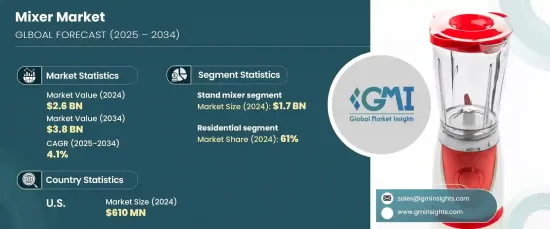
세계의 믹서 시장은 2024년에 26억 달러로 평가되며, 2025-2034년에 CAGR 4.1%로 확대할 것으로 예상되고 있습니다. 홈 베이커리의 인기 급상승, 외식 산업의 지속적인 확장, 식품 제조 자동화의 발전이 이러한 성장을 이끄는 주요 요인으로 작용할 것으로 보입니다. 또한 제과류에 대한 수요 증가와 IoT, AI, 스마트 센서와 같은 신기술의 통합이 시장 전망을 재구성하고 있습니다. 소비자들이 주방 가전제품의 편리성, 소형화, 다용도성을 추구함에 따라 믹서는 가정용 및 상업용 주방에서 필수적인 툴로 자리 잡았습니다. 스마트홈 기술의 부상도 이러한 추세에 일조하고 있으며, 믹서는 디지털 인터페이스를 통해 실시간 데이터 및 정확한 제어와 같은 기능을 제공하여 사용자 경험을 향상시키고 있습니다.

COVID-19로 인해 집에서 요리와 제과를 만드는 것이 유행하면서 소비자들은 보다 효율적이고 사용하기 편리한 주방 기기를 선택하게 되었습니다. 이제 개인은 바쁜 라이프스타일에 맞추어 믹싱, 반죽, 거품기 등의 작업을 쉽게 할 수 있는 작고 다용도로 사용할 수 있는 믹서를 찾고 있습니다. 온라인 쇼핑 플랫폼의 인기가 높아짐에 따라 소비자들이 이러한 가전제품을 쉽게 구매할 수 있게 되면서 주거용 가전제품에 대한 수요도 증가하고 있습니다. 상업용 부문에서는 레스토랑, 카페, 케이터링 서비스 업체들이 식품 제조의 일관성을 보장하고 고품질 식품에 대한 수요 증가에 대응하기 위해 믹서에 대한 의존도가 높아지고 있습니다. 자동화와 스마트 기술은 상업용 주방의 효율성 향상, 실수 감소, 인건비 절감에 필수적인 요소로 자리 잡고 있습니다.
| 시장 범위 | |
|---|---|
| 시작연도 | 2024년 |
| 예측연도 | 2025-2034년 |
| 시작 금액 | 26억 달러 |
| 예상 금액 | 38억 달러 |
| CAGR | 4.1% |
제품 유형별로 볼 때, 시장은 핸드 믹서와 스탠드 믹서로 나뉩니다. 스탠드 믹서는 계속해서 시장을 독점할 것으로 예측되며, 2024년 17억 달러, 2025-2034년 4.3%의 연평균 복합 성장률(CAGR)로 성장합니다. 여러 가지 작업을 수행할 수 있는 믹서는 홈 베이커리 및 요리 애호가들 사이에서 특히 인기가 있습니다. 앱 연결, 홈자동화 시스템과의 호환성 등 스마트 기능을 갖춘 스탠드형 믹서가 인기를 끌고 있습니다. 가볍고 휴대가 간편한 핸드 믹서는 특히 주방이 좁거나 더 많은 유연성을 원하는 사람들 사이에서 수요가 증가하고 있습니다. 무선 모델은 그 편리함으로 인해 점점 더 인기를 얻고 있습니다.
시장은 주거용 최종사용자와 상업용 최종사용자로 구분되며, 2024년 시장 점유율의 약 61%를 차지한 주거용 소비자는 향후에도 성장을 주도할 것으로 예상됩니다. 경량 핸드믹서, 소형 스탠드 믹서 등 공간을 차지하지 않는 컴팩트한 디자인은 도시 생활 환경에서 특히 매력적입니다. 상업용 부문에서는 프로그래밍 가능한 제어, IoT 연결, 자동 설정 기능을 갖춘 스마트 믹서가 일관성을 유지하고 효율성을 향상시키면서 생산 규모를 확대하고자 하는 기업에게 필수적인 요소가 되고 있습니다. 퀵서비스 레스토랑과 음식 배달 모델의 발전은 대량 생산에 대응할 수 있는 고속 및 대용량 믹서에 대한 수요를 더욱 증가시키고 있습니다.
미국에서는 홈 베이커리, 기술 혁신, 상업용 믹서 사용의 급격한 증가에 힘입어 믹서 시장이 빠르게 성장할 것으로 예상되며, 2024년 시장 규모는 6억 1,000만 달러로 추정되며, 미국은 북미 믹서 시장을 계속 선도하고 있습니다. 소비자들이 온라인 쇼핑을 점점 더 많이 이용함에 따라 다용도, 고품질 믹서에 대한 수요는 계속 증가할 것입니다.
The Global Mixer Market was valued at USD 2.6 billion in 2024 and is expected to expand at a CAGR of 4.1% from 2025 to 2034. The surge in popularity of home baking, the ongoing expansion of the food service industry, and advancements in automation for food production are major factors fueling this growth. Additionally, there is a growing demand for baked goods, as well as the integration of new technologies like IoT, AI, and smart sensors, which are reshaping the market landscape. As consumers increasingly seek convenience, compactness, and versatility in their kitchen appliances, mixers have become indispensable tools in both home and commercial kitchens. The rise of smart home technology has further contributed to this trend, with mixers offering features like real-time data and precise control through digital interfaces, enhancing user experience.

The pandemic saw a boom in home cooking and baking, with consumers opting for more efficient and user-friendly kitchen equipment. Now, individuals are looking for compact and multipurpose mixers that cater to busy lifestyles, making tasks like mixing, kneading, and whipping easier. The growing popularity of online shopping platforms has also made it easier for consumers to purchase these appliances, boosting demand in the residential sector. On the commercial side, restaurants, cafes, and catering services are increasingly relying on mixers to ensure consistency in food production and meet the growing demand for high-quality food. Automation and smart technologies are becoming essential for improving efficiency, reducing errors, and cutting labor costs in commercial kitchens.
| Market Scope | |
|---|---|
| Start Year | 2024 |
| Forecast Year | 2025-2034 |
| Start Value | $2.6 Billion |
| Forecast Value | $3.8 Billion |
| CAGR | 4.1% |
In terms of product type, the market is divided into hand mixers and stand mixers. Stand mixers are projected to continue dominating the market, with an estimated value of USD 1.7 billion in 2024, growing at a CAGR of 4.3% from 2025 to 2034. These mixers, which handle multiple tasks, are especially popular among home bakers and culinary enthusiasts. Stand mixers with smart features, such as app connectivity and compatibility with home automation systems, are gaining traction. Hand mixers, which are lighter and more portable, are also in demand, particularly among those with smaller kitchens or those looking for more flexibility. Cordless models are becoming increasingly popular for their convenience.
The market is segmented into residential and commercial end users. Residential consumers, who held about 61% of the market share in 2024, are expected to continue driving growth. Compact designs that save space, such as lightweight hand mixers and smaller stand mixers, are particularly appealing in urban living environments. In the commercial sector, smart mixers equipped with programmable controls, IoT connectivity, and automated settings are becoming essential for businesses aiming to scale production while maintaining consistency and improving efficiency. The growing trend of quick-service restaurants and food delivery models is further fueling demand for high-speed, high-capacity mixers that can handle bulk production.
In the U.S., the mixer market is expected to grow rapidly, driven by trends like home baking, technological innovations, and a surge in commercial mixer usage. With an estimated market value of USD 610 million in 2024, the U.S. continues to lead the North American mixer market. As consumers increasingly embrace online shopping, the demand for versatile and high-quality mixers is only expected to rise.